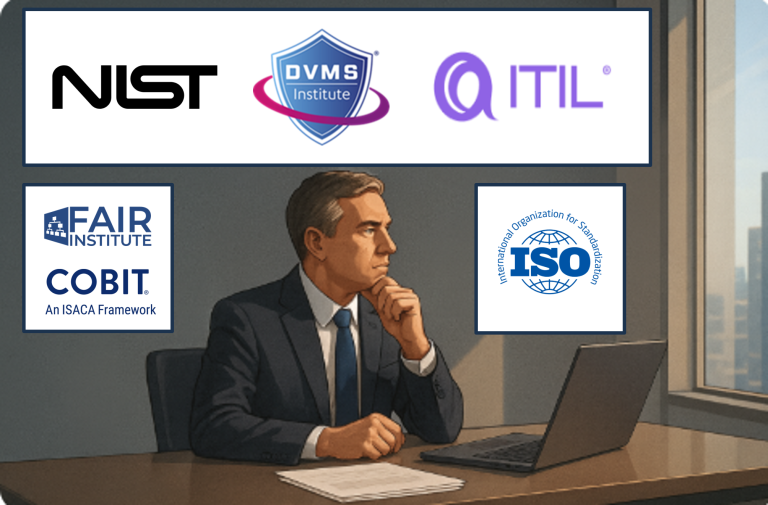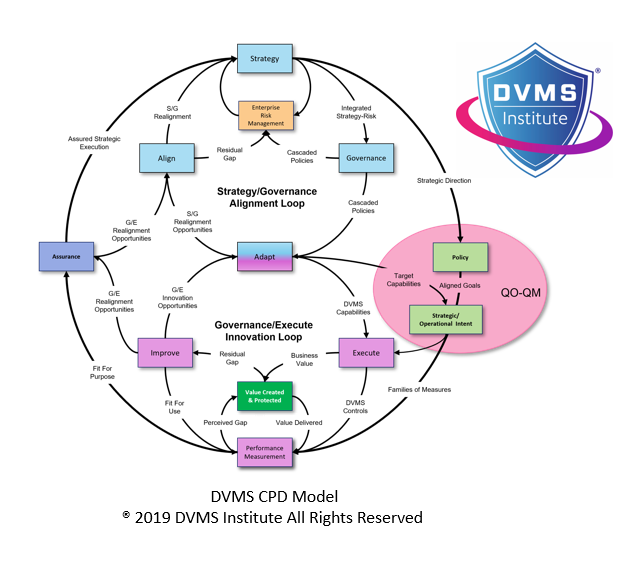Boosting ITIL with DVMS to Enable Cyber Resilient Business Outcomes
Rick Lemieux – Co-Founder and Chief Product Officer of the DVMS Institute
In a digital economy where enterprise performance hinges on IT services’ reliability, security, and adaptability, traditional IT Service Management (ITSM) frameworks like ITIL face mounting pressure to evolve. While ITIL provides a robust structure for managing IT services, it has often struggled with implementation gaps, siloed processes, and misalignment with enterprise strategy and risk.
The Digital Value Management System® (DVMS), developed by the DVMS Institute, addresses these shortcomings by acting as an operational overlay that integrates ITIL’s capabilities into a broader system of strategic governance, organizational learning, and business value protection. Through this integration, the DVMS enables ITSM frameworks like ITIL to deliver not just service outcomes, but meaningful digital business outcomes.
Moving from Process Compliance to Strategic Contribution
ITIL’s strength lies in standardizing processes around service delivery, including incident management, change management, and service desk operations. However, its implementation often becomes a checkbox activity focused on compliance rather than value. The DVMS shifts this paradigm by embedding ITSM practices into a value-driven, risk-informed structure. It transforms ITIL from a set of best practices into an adaptive component of a larger strategic system. Specifically, the DVMS recognizes that IT is not merely a support function but a core driver of digital business value—and therefore must be governed, measured, and improved with this in mind.
By placing service management in the context of “strategy-risk,” the DVMS demands that IT services align with enterprise strategy, risk appetite, and mission objectives. This means that service design and delivery are evaluated for efficiency and their contribution to resilience, agility, and stakeholder value.
The DVMS Overlay: Clarifying Purpose, Exposing Gaps
Where ITIL lays out what should be done in IT service delivery, the DVMS clarifies why and how. The DVMS is not a replacement for ITIL. It is an overlay that operationalizes and contextualizes its practices across seven Minimum Viable Capabilities (MVCs): Govern, Assure, Plan, Design, Change, Execute, and Innovate. Every ITIL practice—such as Service Request Management or Change Enablement—maps to one or more of these capabilities.
For example, the Govern capability ensures that policies for change approval align with the enterprise strategy. The Assure capability validates that service level agreements (SLAs) and operational level agreements (OLAs) are tracked and evaluated against business objectives. The Plan and Design capabilities ensure that services are architected with risk, value, and adaptability in mind—not just cost or availability.
This structure transforms ITSM from a service-centric function to a value-centric contributor. The overlay allows organizations to identify which capabilities are missing or underperforming—within IT and across interconnected service and business domains. In this way, ITIL processes become part of a dynamic, strategic system capable of identifying and closing performance gaps.
Enabling Agile Execution and Continual Innovation
ITIL has recently evolved to embrace agility and continual improvement, particularly in its 4th edition. However, implementation often stalls when organizations attempt to reconcile agility with governance. The DVMS resolves this tension through its FastTrack™ phased approach—Initiate, Basic Hygiene, Expand, and Innovate—which enables iterative improvement across IT and business domains.
Within this model, ITSM capabilities are first stabilized (“Basic Hygiene”), then scaled (“Expand”), and eventually evolved through innovation (“Innovate”). For instance, Change Management in ITIL can move from a bureaucratic, form-based process to an adaptive, risk-informed capability that supports rapid deployment and secure operations—because the DVMS demands execution and innovation as concurrent responsibilities.
By treating innovation not as a luxury but a minimum viable capability, the DVMS ensures that ITSM frameworks do not merely support the business—they drive it forward.
Strategic Measurement and Learning Through the CPD Model
ITIL promotes continual improvement via its seven guiding principles, but it leaves the development of effective metrics to the organization. The DVMS addresses this gap through its CPD (Create, Protect, Deliver) Model and QO-QM (Question-Outcome–Question-Metric) methodology. This model ties ITSM activities directly to business value by framing each service activity around three questions: What value is being created? How is it being protected? And how is it being delivered to stakeholders?
The CPD Model applies systems thinking to understand how ITSM processes interact with other organizational systems. For instance, when a configuration management database (CMDB) changes impacts service availability, the DVMS CPD Model asks whether the SLA was breached and whether the breach meaningfully impacted stakeholder trust or business outcomes. This elevates measurement from a technical exercise to a strategic feedback loop.
Driving Cultural Transformation and Resilience
ITIL frameworks often stumble when cultural resistance undermines process adoption. Again, the DVMS adds immense value by treating culture as a strategic asset. Using systems models like the Cultural Web and Iceberg Model, DVMS identifies how assumptions, norms, and invisible power structures within IT and across business units either support or obstruct effective service delivery.
The DVMS makes culture measurable, observable, and improvable. It recognizes that service outcomes depend not only on defined processes, but also on how people behave, communicate, and make decisions under pressure. ITIL’s “focus on value” principle becomes far more actionable when embedded in a culture of accountability, transparency, and learning—conditions the DVMS is designed to cultivate.
Unifying ITSM with Cybersecurity and Risk Management
Finally, the DVMS positions ITSM as a natural ally of cybersecurity and enterprise risk management. Through its integration with the NIST Cybersecurity Framework (CSF), the DVMS ensures that ITSM activities—from change management to service continuity—are not isolated, but interdependent with the organization’s security posture.
For example, the Protect function in the NIST CSF depends on properly implemented ITSM practices like access management, backup and restore operations, and patch management. The DVMS ensures these are governed and executed not in isolation, but in sync with broader enterprise risk objectives.
In this sense, DVMS turns ITIL from a back-office framework into a frontline contributor to digital resilience. Service reliability, continuity, and user satisfaction are not just operational metrics—they become leading indicators of business trust, regulatory compliance, and market competitiveness.
Conclusion: A Blueprint for Service-Driven Success
ITIL alone cannot deliver the strategic IT outcomes that modern enterprises require. It needs a unifying model that aligns service delivery with strategic goals, risk tolerance, cultural readiness, and innovation capacity. The Digital Value Management System provides this model. By embedding ITSM within a holistic, value-focused system of governance and learning, the DVMS enables organizations to transform service management into a driver of digital business success.
Through its structured overlay, cultural insight, systems thinking, and strategic alignment, the DVMS helps ITIL deliver not only services but also outcomes that matter.
About the Author

Rick Lemieux
Co-Founder and Chief Product Officer of the DVMS Institute
Rick has 40+ years of passion and experience creating solutions to give organizations a competitive edge in their service markets. In 2015, Rick was identified as one of the top five IT Entrepreneurs in the State of Rhode Island by the TECH 10 awards for developing innovative training and mentoring solutions for boards, senior executives, and operational stakeholders.
In today’s digitally driven economy, cyber disruptions are no longer an “if” but a “when.”
The DVMS Institute’s Certified Training Programs teach organizations the skills to build a Holistic and Culture-Aligned Overlay System capable of coordinating Cyber Operational Resilience actions across a Complex Digital Ecosystem.
Achieving true cyber operational resilience requires seamless alignment between organizational Strategy, Governance, and Operations, underpinned by a culture dedicated to sustaining and continuously innovating the Creation, Protection And Delivery of organizational digital value.

The DVMS positions cyber resilience as a strategic, enterprise-wide capability powered by your best practice systems (NISTCSF, ITSM, GRC etc.) and the DVMS MVC, CPD, and 3D Knowledge models.
This systems-based approach to cyber operational resilience demands active engagement from all members of the Digital Ecosystem. Each member plays a distinct role in proactively identifying and mitigating the systemic risks that threaten digital business operations.
This forward-looking approach to adaptive Governance, Resilience, and Assurance (GRA) positions businesses to:
- Maintain Operational Stability Amidst Constant Digital Disruption
- Drive Agility and Trust Across Your Digital Ecosystem
- Satisfy Critical Regulatory and Certification Requirements
- Leverage Cyber Resilience as a Competitive Advantage
DVMS Explainer Videos
- Architecture Video: David Moskowitz explains the DVMS System
- Case Study Video: Dr. Joseph Baugh Shares His DVMS Story.
- Overlay Model – What is an Overlay Model
- ZX Model – The MVC’s that power operational resilience
- CPD Model – Adaptable governance and assurance
- 3D Knowledge Model – Enabling holistic organizational learning
- FastTrack Model – A phased approach to cyber resilience
Digital Value Management System® is a registered trademark of the DVMS Institute LLC.
® DVMS Institute 2025 All Rights Reserved




